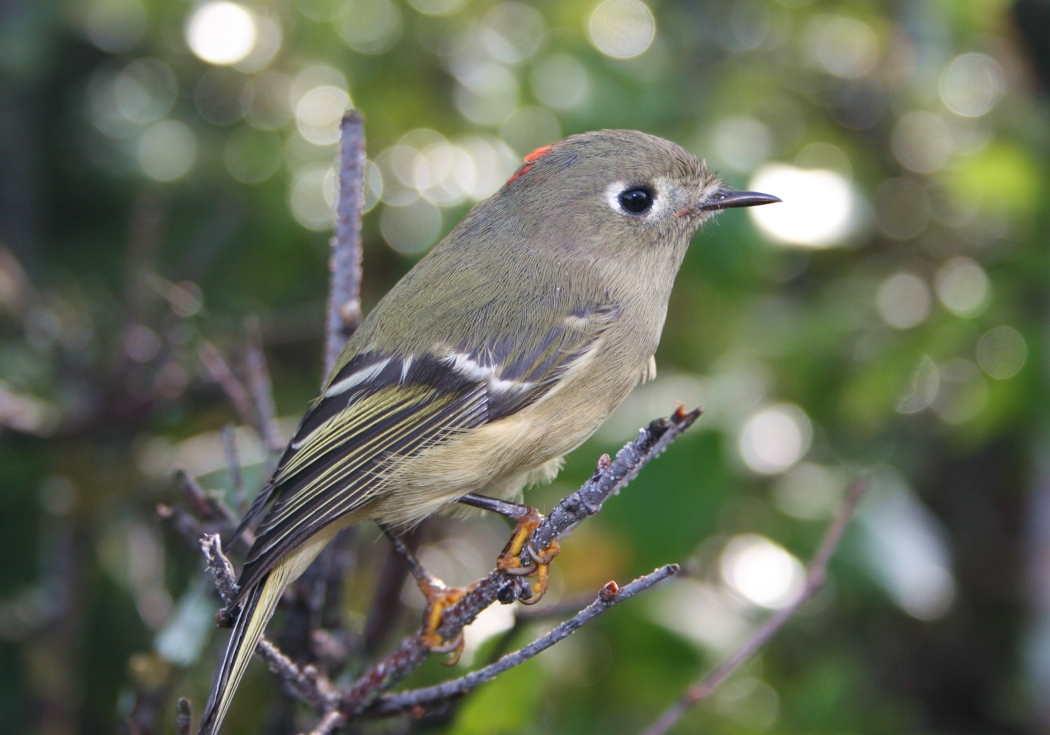- Ruby-crowned Kinglet
Taxobox
name = Ruby-crowned Kinglet
status = LC | status_system = IUCN3.1

image_width = 240px
regnum =Animal ia
phylum = Chordata
classis = Aves
ordo =Passeriformes
familia =Regulidae
genus = "Regulus
species = "R. calendula"
binomial = "Regulus calendula"
binomial_authority = (Linnaeus, 1766)The Ruby-crowned Kinglet ("Regulus calendula") is a very small
songbird of theKinglet family Regulidae native toNorth America . Both the male and female have olive-grey plumage with a thin black bill and short tail. The male bears a red crown which gives the bird its common name.Taxonomy
The Ruby-crowned Kinglet was described in 1766 by Linnaeus; its generic name is
Latin for 'little king'. The Kinglets are a group which appear to be only distantly related to all other passerines. The Ruby-crowned Kinglet differs sufficiently in its voice and plumage from other kinglets that it is occasionally be afforded its own genus, "Corthylio".Description
Adult birds are olive-grey on the upperparts with light underparts, with a thin black bill and a short tail. They have white wing bars and a white broken eye ring. The adult male has a red patch on his crown which is usually only visible when he is agitated.
Their song is a melodious warble and fairly loud, but at least in winter habitat, the most common vocalization is a wren-like scolding "jdit", often repeated several times in close succession. On breeding grounds, they sometimes deliver a prolonged and monotonous "chirrup" call that can be heard for long distances. [Ingold, J. L. and G. E. Wallace. 1994. Ruby-crowned Kinglet (Regulus calendula), The Birds of North America Online (A. Poole, Ed.). Ithaca: Cornell Lab of Ornithology; Retrieved from the Birds of North America Online: http://bna.birds.cornell.edu/bna/species/119]
Distribution and habitat
Their breeding habitat is
conifer ous forests acrossCanada ,Alaska , northernNew England and the westernUnited States . They nest in a well-concealed hanging cup suspended from a conifer branch and may lay as many as twelve eggs in a clutch.The recent counting indicates that the Ruby-crowned Kinglet population is on the rise. This is mainly due to discovery of less disturbed territory farther north. This allows more successful breeding.
These birds migrate to the southern United States and
Mexico . Some birds are permanent residents in the west.Behaviour
They forage actively in trees or shrubs, mainly eating small insects and
spider s, some berries and tree sap. They may hover over a branch while feeding and sometimes fly out to catch insects in flight.References
* Database entry includes justification for why this species is of least concern
External links
* [http://www.birds.cornell.edu/AllAboutBirds/BirdGuide/Ruby-crowned_Kinglet.html Ruby-crowned Kinglet] - Cornell Lab of Ornithology
* [http://www.sdakotabirds.com/species/ruby_crowned_kinglet_info.htm Ruby-crowned Kinglet Information and Photos] - South Dakota Birds and Birding
* [http://www.mbr-pwrc.usgs.gov/id/framlst/i7490id.html Ruby-crowned Kinglet "Regulus calendula"] - USGS Patuxent Bird Identification InfoCenter
Wikimedia Foundation. 2010.
